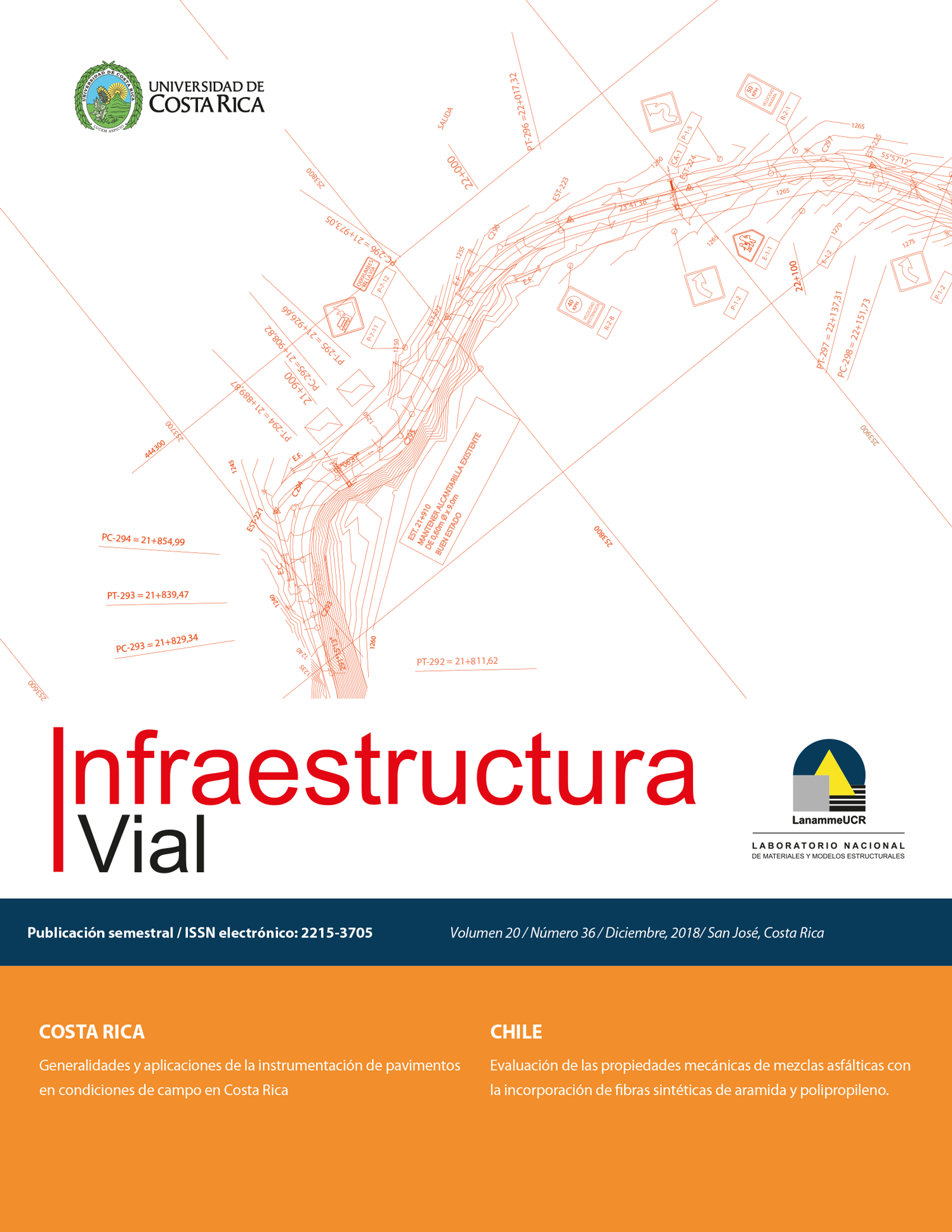Abstract
Roads are exposed to external conditions such as rain, solar radiation and the increase of vehicular flow, among others; which generates distresses on asphalt pavements. It is necessary to research new technologies being able to improve the behavior of pavements against external conditions. Currently, the use of polymer modified asphalts is one of the most used alternatives, because they provide a greater durability to the pavement structure. However, literature review has shown that there are other competitive techniques to obtain good results, such as the use of synthetic fibers. Therefore, the main objective of this research is to evaluate the influence of the addition of aramid and polypropylene synthetic fibers in the mechanical properties of asphalt mixtures.For this purpose, a IV-A-12 asphalt mixture (mainly used in Chile) with a CA-24 asphalt binder (according to Chilean specifications) were manufactured, incorporating different percentages of synthetic fibers. The mechanical properties of the modified asphalt mixtures were compared with a reference hot asphalt mixture. Through the experimental phase, thermal cracking, moisture damage and rutting properties were evaluated. The results have shown that the use of aramid and polypropylene fibers in asphalt mixtures reduced the moisture damage and rutting, nevertheless the thermal cracking was improved.
References
Abiola, O. S., Kupolati, W. K., Sadiku, E. R., & Ndambuki, J. M. (2014). Utilisation of natural fibre as modifier in bituminous mixes: A review. Construction and Building Materials, 54, 305–312. https://doi.org/10.1016/j.conbuildmat.2013.12.037
Abtahi, S. M., Sheikhzadeh, M., & Hejazi, S. M. (2010). Fiber-reinforced asphalt-concrete - A review. Construction and Building Materials, 24(6), 871–877. https://doi.org/10.1016/j.conbuildmat.2009.11.009
Afonso, M. L., Dinis-Almeida, M., & Fael, C. S. (2017). Study of the porous asphalt performance with cellulosic fibres. Construction and Building Materials, 135, 104–111. https://doi.org/10.1016/j.conbuildmat.2016.12.222
Ahmad, A., & Kareem, Y. (2015). Fatigue Behavior of Polypropylene Fiber Reinforced Bituminous Concrete Mix, 4(02), 449–453.
Al-Hadidy, A. I., & Yi-qiu, T. (2009). Effect of polyethylene on life of flexible pavements. Construction and Building Materials, 23(3), 1456–1464. https://doi.org/10.1016/j.conbuildmat.2008.07.004
Aliha, M. R. M., Razmi, A., & Mansourian, A. (2017). The influence of natural and synthetic fibers on low temperature mixed mode I + II fracture behavior of warm mix asphalt (WMA) materials. Engineering Fracture Mechanics, 182, 322–336. https://doi.org/10.1016/j.engfracmech.2017.06.003
Chen, H., Xu, Q., Chen, S., & Zhang, Z. (2009). Evaluation and design of fiber-reinforced asphalt mixtures. Materials and Design, 30(7), 2595–2603. https://doi.org/10.1016/j.matdes.2008.09.030
Haddadi, S., Ghorbel, E., & Laradi, N. (2008). Effects of the manufacturing process on the performances of the bituminous binders modified with EVA. Construction and Building Materials, 22(6), 1212–1219. https://doi.org/10.1016/j.conbuildmat.2007.01.028
Huang, H., & White, T. D. (1996). Dynamic Properties of Fiber-Modified. Transportation Research Record: Journal of the Transportation Research Board, 98–104. Retrieved from https://doi.org/10.3141/1545-13
ITEM 400 HS. (1998). Standard specification for asphalt concrete - high stress using polypropylene fibers Using polypropylene Fibers. Flexible Pavements Inc.
Kaloush, K. E., Biligiri, K. P., Zeiada, W. A., Rodezno, M. C., & Reed, J. X. (2010). Evaluation of Fiber-Reinforced Asphalt Mixtures Using Advanced Material Characterization Tests. Journal of Testing and Evaluation, 38(4), 102442. https://doi.org/10.1520/JTE102442
Kaloush, K. E., Zeiada, W. A., Biligiri, K. P., Rodezno, M. C., & Reed, J. X. (2010). Evaluation of Fiber-Reinforced Asphalt Mixtures Using Advanced Material Characterization Tests. Journal of Testing and Evaluation, 38(4), 102442. https://doi.org/10.1520/JTE102442
Kutay, M. E., Gibson, N., & Youtcheff, J. (2008). Kutay, M. E., Gibson, N., & Youtcheff, J. In Conventional and viscoelastic continuum damage (VECD) - Based fatigue analysis of polymer modified asphalt pavements.
Mello, L. G., Kaloush, K. E., & Biligiri, K. P. (2008). Evaluation of Fiber Reinforcement in Hot Mix Asphalt Using Advanced Material Characterization Tests. In The First Pan American Geosynthetics Conference & Exhibition 2-5 March 2008, Cancun, Mexico(pp. 0–7).
Pamulapati, Y., Elseifi, M. A., Cooper, S. B., Mohammad, L. N., & Elbagalati, O. (2017). Evaluation of self-healing of asphalt concrete through induction heating and metallic fibers. Construction and Building Materials, 146, 66–75. https://doi.org/10.1016/j.conbuildmat.2017.04.064
Reyes, O ., Camacho, J. & Mejia, M. (2017). Resistencia mecánica y dinámica de mezclas asfálticas adicionadas con fibras sintéticas. Congreso Ibero-Latinoamericano Del Asfalto CILA XX.
Valdés, G., Pérez-Jiménez, F., & Botella, R. (2009). Ensayo Fénix, una Nueva Metodología para Medir la Resistencia a la Fisuración en Mezclas Asfálticas. Revista de La Construccion, 8(1), 114–125.
Valdés V, G. A., Pérez-Jiménez, F. E., & Botella N, R. (2013). Nuevo procedimiento para evaluar el comportamiento a fatiga en pavimentos asfálticos a través del ensayo Fénix New procedure to assess the fatigue behavior in asphalt pavements by Fénix test. Ingeniare. Revista Chilena de Ingeniería, 21(3), 362–371. https://doi.org/10.4067/S0718-33052013000300006
Wu, S., Ye, Q., & Li, N. (2008). Investigation of rheological and fatigue properties of asphalt mixtures containing polyester fibers. Construction and Building Materials, 22(10), 2111–2115. https://doi.org/10.1016/j.conbuildmat.2007.07.018
Wu, S., Ye, Q., Li, N., & Yue, H. (2007). Effects of fibers on the dynamic properties of asphalt mixtures. Journal of Wuhan University of Technology-Mater. Sci. Ed., 22(4), 733–736. https://doi.org/10.1007/s11595-006-4733-3
Xu, Q., Chen, H., & Prozzi, J. A. (2010). Performance of fiber reinforced asphalt concrete under environmental temperature and water effects. Construction and Building Materials, 24(10), 2003–2010. https://doi.org/10.1016/j.conbuildmat.2010.03.012
Yang, J. M., Kim, J. K., & Yoo, D. Y. (2016). Effects of amorphous metallic fibers on the properties of asphalt concrete. Construction and Building Materials, 128, 176–184. https://doi.org/10.1016/j.conbuildmat.2016.10.082
Yoo, P. J., & Kim, T. W. (2015). Strengthening of hot-mix asphalt mixtures reinforced by polypropylene-impregnated multifilament glass fibres and scraps. Construction and Building Materials, 75, 415–420. https://doi.org/10.1016/j.conbuildmat.2014.11.009


